Driven Pheasants at Highland Hills Ranch With Chris Batha
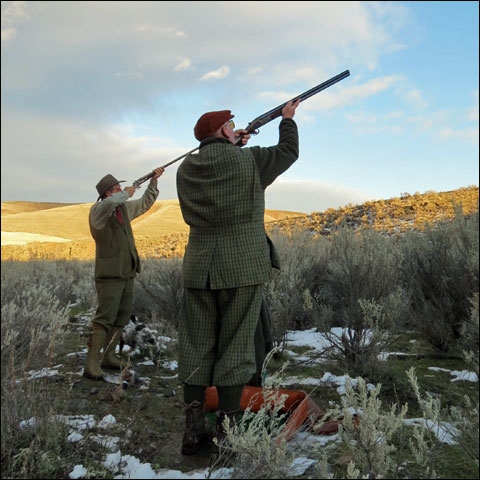
At an elevation approaching 3,000 feet, the high-desert terrain cut a razor-sharp horizon across Highland Hills Ranch. A chukar flushes, you wheel around, experience the rush of a game bird escaping against the silk-blue sky and when the stock of the 20 gauge touches your cheek a single detonation punctuates an indelible instant high on the threshold of eternity.
But that was day four…
Turning back the clock, my rental car from Portland International Airport navigated down the snowy, snaky road into a steep ravine until the image stamped on the bucket list of upland enthusiasts of the Highland Hill Ranch lodge figured prominently on the hilltop. The elegant log creation illuminated golden comfort through towering windows. After the three-hour drive you step out from behind the wheel into the frosty white landscape and the air is sharp, clean and sobering — unambiguous in its integrity.
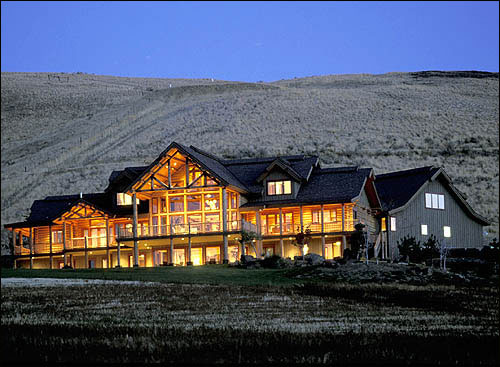 The iconic Highland Hills Ranch lodge.
The iconic Highland Hills Ranch lodge.
The occasion promised big. A driven pheasant shoot hosted by British author, instructor, gunmaker, stock fitter and international guide, Chris Batha. Of immense intelligence and rapier wit, Mr. Batha substitutes England’s bird havens with the kindred landscape of Highland Hills Ranch to show us Yanks how it’s done on ye auld sod.
Highland Hills Ranch owner, Dennis Macnab, thrives on the bloodline of a Scotsman and with his wife and business partner Mindi the two successful Americans orchestrate the spectacle and hospitality of an ancestral estate driven shoot in Northeast Oregon.
First stop, though, was the bar.
Open the front door of the lodge and you’re awash in the warmth of superb, honey-hued, hand-peeled timbers that attain a vaulted ceiling buttressed by exposed beams. There’s an inspiration of Native American felt among the plush lodge décor and colossal stone fireplace. A spacious open kitchen replete with granite counters suggests some mighty fine home cooking served up in the adjacent, rustic dining room. With six guest rooms in the lodge, you were mere steps away from gourmet indulgences.
 The Great Room of the Highland Hills Ranch Lodge.
The Great Room of the Highland Hills Ranch Lodge.
Did the Macnabs intend to spoil us? Probably. Highland Hills Ranch is a two-time recipient of Orvis’ Lodge of the Year, most recently for the 2012-2013 season. Highland Hills Ranch is also a charter member of the Beretta Trident Program, which is the first and only system to rate shooting sports venues — a rarified achievement considering that only five percent of destinations worldwide are considered good enough to merit even one Trident. You can see why the collection of accolades is a theme of the Highland Hills Ranch legend, but for now, with voices arising from the bar downstairs, I could use a wee dram or two of road-straightener.
As the latecomer, most of the shooting party and their significant others have gained a head start on the evening festivities. It’s a handsome, prosperous group, including a clutch of friends from previous driven shoots here led by Mr. Batha. I’d discover that through Highland Hills Ranch their relationships deepened to where they now hunt birds together in Europe with Mr. Batha organizing the expeditions.
 Dennis Macnab (left) with Chris Batha in the field for a driven pheasant shoot at Highland Hills Ranch.
Dennis Macnab (left) with Chris Batha in the field for a driven pheasant shoot at Highland Hills Ranch.
At the bar, hors d’oeuvres, top-shelf spirits and mixed party nuts lubricated the appetite and conversation in the intimate quarters. An undertone of convivial one-upmanship assessed the group’s tenderfoot, but I can take it and dish it out too with admirable appreciation. The warm glow of camaraderie now about us, dinner is ready.
Chef Keith Potter has helmed the kitchen since 2004, defining the cuisine credited with scoring high marks by Orvis, Beretta Trident and guests. The three daily meals tendered by Chef Potter rewarded the palate and belly with deep, complex flavors and abundant fortitude realized through a fusion of Western, Latin and Pacific Rim influences. A hallmark was homemade baked breads that perfumed the dining room. In his words, “I strive to be elegant without being pretentious. I want my food to be beautiful, but more importantly to taste good.”
Although the wine cellar at Highland Hills Ranch is outstanding, one of the shooting party’s member was the CEO of a national restaurant chain. Prior to the arrival of Mr. Batha’s contingent, he had hosted a corporate upland shoot to reward high performers. Sharing his remaining personal reserve of 90-point reds from Napa Valley complemented Chef Potter’s meals with an especially sumptuous pleasure. Dinners at Highland Hills Ranch percolated with conviviality practically impossible to find elsewhere. But how did the Macnabs do it?
I believe the rare delight was attributed to the size of the table and nature of the servers. The dark-wood furniture of 11 by 4 feet held the ideal balance of geniality and opulence. Usually we find ourselves talking with the closest people, but the table at Highland Hills Ranch lets you actually converse with someone across the way without raising your voice too much — just the right decibel level for a good punch-line. The dynamic gave rise to a cross-current of lively sociability during the course of a long, satisfying repast.
The servers, meanwhile, showed the attentiveness of a thoughtful nurse. Approaching from behind, they placed a tender hand on your shoulder and leaned in toward the table to serve or clear, kindly asking about food and drink with an endearing warmth in their eyes.
Yes, the dinners at Highland Hills Ranch made you yearn for Thanksgiving family get-togethers that would thus come to pass.
 Pheasants harvested from a driven shoot at Highland Hills Ranch.
Pheasants harvested from a driven shoot at Highland Hills Ranch.
Outside, the Milky Way and constellations that once marveled us in childhood whispered of mortality to my elder self. The widespread crust of snow wisely counseled the use of a house Toyota Land Cruiser instead of that puny rental import. More safari stalwart than mommy runabout, the decade-old SUV with its honorable patina of ranch grime rattled along the graded road for roughly a mile to my cabin overlooking a valley of feed plots and desert flora — one of five guest accommodations partaking in the view, plus a “mini-lodge” at the far end of the row.
The double-occupancy cabin provided abundant floor space for gear, which counted on the bulky side since I had reached Highland Hills Ranch straight from a duck hunt at Beaver Dam Lake in Mississippi, celebrated for character and abundance by the definitive American outdoor writer, Nash Buckingham.
Suddenly, it was so quiet.
Come morning, Chef Potter cooked delicious shirred eggs — a.k.a. eggs baked in individual buttered gratin dishes. If baked eggs sound hideous, his preparations, always enriched with cheese, varied from day to day and each surprised with savory gratification. I had arrived as a baked-egg skeptic and left Highland Hills Ranch as a convert.
 Mindi Macnab with Dudley Coleman.
Mindi Macnab with Dudley Coleman.
Directly following breakfast, Mr. Batha conducted a safety and etiquette clinic in the lodge. The time arrived to gear up. We would adhere to a four-day schedule, immediately commencing with a simulated driven pheasant clinic conducted by Mr. Batha. Days two and three of the actual shoot were reserved for the Highland Hills Ranch British Driven Pheasant Shoot. We would have a crack at more than 900 high-flying pheasants during three drives per day. And day four would inevitably carry me to that heavenly plain shooting chukars over dogs.
Our party of eight was driven on the rolling, curvy dirt roads and across rock-strewn rivers and streams to a ravine bounded by escarpments. A makeshift camp appeared, outfitted with tables, chairs, beverages, portable gun racks and firewood. We confronted a 90-foot-high basalt cliff where two trap machines threw overhead slow curling right and fast left targets. With gusts exceeding 35 miles per hour in the wind-tunnel ravines, targets frolicked on the currents —foreshadowing the wanton velocity of airborne pheasants.
 Michael Kendrick shooting simulated driven pheasants.
Michael Kendrick shooting simulated driven pheasants.
The group’s knowledge of simulated driven-pheasant targets ran the gamut. Champion shooter Michael Coleman, who was also a partner in Windwalker Farm Sporting Clays in Stanton, Texas, donated his enormous expertise and talent by coaching whenever Mr. Batha devoted personal attention to shooters stuck on problem targets. Michael Kendrick, a long-standing client of Mr. Batha, exhibited top form of the Churchill Method for high, driven birds. While both men shot traditional British bird guns, Brian Yamamoto executed seemingly impossible pheasant shots with his tricked-out clays gun, a Krieghoff K-80. The remaining participants covered the skills spectrum, including quick-study Vivian Pearce who elicited cheers from nearby pegs after downing tricky pheasants.
 Brian Yamamoto was absolutely lethal on driven pheasants shooting his Krieghoff K-80 clays gun.
Brian Yamamoto was absolutely lethal on driven pheasants shooting his Krieghoff K-80 clays gun.
In addition to catching up on the basics, though, Mr. Batha’s clinic offered trigger time with a new Perazzi MX20.
The Italian gunmaker is celebrated for indestructible over/unders that routinely garner gold medals in clays competitions worldwide — including the Olympics. Bespoke and impeccable, the design ethos akin to Formula 1 race-car engineering leads upland hunters to preclude Perazzi’s in their pursuit of a virtuoso bird gun.
During the demanding hunting schedule at Highland Hills Ranch, I ultimately came to realize that the Perazzi MX20 functioned as a 7½ pound death ray for upland prey. Not quite as nimble as other best 20 gauges from the likes of Purdey or Holland & Holland, a standard MX20 cost about one-tenth the price with precise, confident handling that is worth the $11,000.
 The Perazzi MX20 on a stream-side peg at Highland Hills Ranch.
The Perazzi MX20 on a stream-side peg at Highland Hills Ranch.
The MX20’s secret sauce has two leading ingredients: supreme balance and intuitive trigger. You could easily argue that it’s hefty for a field gun, but shooting it for both driven and walk-up hunts demonstrated consistent stability in shouldering, pointing and timing. It imposed a measured yet smooth style that forced you to reckon with the bird at hand before triggering the shot. “Whippy” is not in the MX20 idiom. You never worried that a flushed bird would get away; when your eyes locked on the chukar, you knew it was easily dead.
Perazzi’s are renowned for the barrel regulation — meaning they accurately shoot where you point. Some shotgun makers get sloppy with barrel regulation and often the owner goes through the frustrating and expensive routine of gun fit, patterning and lessons with perhaps never discovering the barrels are crazy.
The standard MX20 ships with either a blue or nickel, sculpted receiver bearing minimal border braid engraving. Very wide knuckles, extra-large hinge pins and bifurcated side lumps give all Perazzis a tremendous amount of metal to metal surface area for enduring reliability. You’d be hard-pressed to find a Perazzi that shakes itself loose over the years.
Perazzi triggers are coveted for crisp pulls at some 3½ pounds. Although many competition Perazzi’s ship with removable mechanical trigger groups built on V-springs, the Perazzi I shot included a fixed single selective inertia trigger with coil springs.
My MX20 arrived with 29½-inch, half-ventilated side-rib barrels. The longer barrels contributed to some of my best walk-up shooting, but other lengths are available from 26 inches through 34 inches. The gun also featured screw-in chokes (althogh fixed are available). If there’s one rap against Perazzi’s it’s the simplicity of their wood. Understated comes to mind for my particular MX20, with oil-finished Turkish walnut subtly figured. The pistol grip and Prince of Wales forend enhanced control.
 A pair of Wirehaired Pointing Griffons owned by guide John Kohnke fetched birds at the Highland Hills Ranch driven pheasant shoot.
A pair of Wirehaired Pointing Griffons owned by guide John Kohnke fetched birds at the Highland Hills Ranch driven pheasant shoot.
Quartering and curling away, the simulated pheasant shots proved difficult, particularly in the wind. With the clays clinic wrapped up, sipping bourbon near the bonfire, I regarded the frosty landscape as evening materialized around us. Over nine-hundred pheasants would crowd the sky beginning tomorrow.
The deep canyons confined the birds to the natural habitat cultivated by the Macnabs. The property, laced with creeks and rivers, along with bunchgrass, sage and alders, already bestowed prime, natural habitation. With the eye of a native son, Mr. Macnab immediately recognized the promise of Highland Hills Ranch.
 Highland Hills Ranch guide, Melissa Herz.
Highland Hills Ranch guide, Melissa Herz.
Mr. Macnab’s family had farmed the area for nearly 130 years. He grew up there hunting birds and over the years, after becoming a successful dentist, wanted to recreate the joys of his boyhood through restoration of the ranch. He purchased it in 1996 with the sole purpose of using it for his own hunting while upholding his farming heritage.
The family who had owned it raised cattle. Although the land had been grazed to the nub, because of the network of water and high-desert topography there persisted quality hun, chukar and quail hunting. Mr. Macnab decided to embark on a conservation and restoration program.
 Chris Batha (left) provides shooting tips to Michael Kendrick during the driven pheasant shoot.
Chris Batha (left) provides shooting tips to Michael Kendrick during the driven pheasant shoot.
His blueprint for Highland Hills Ranch supplemented the enormous native bird population with a program developed to acclimate waves of new releases to the wild. Beginning in October 2001, lodging was constructed with the ribbon cutting of Highland Hills Ranch taking placing in September 2002. Almost immediately, Highland Hills Ranch attracted media coverage by the Wall Street Journal, Financial Times, magazines and TV shows. By the third year, Highland Hills Ranch had skyrocketed to a top upland destination in America.
Driven pheasant shoots started in 2007. Dale Tate and Mr. Batha helped the Macnabs initiate and grow the events. With both English gentlemen now hosting three to five driven shoots per year, Highland Hills Ranch has attracted a core group of regulars. In fact, of the four driven pheasant shoots scheduled for 2014, two have already been sold out.
Now it was our time to benefit from the hard work of Mr. and Mrs. Macnab.
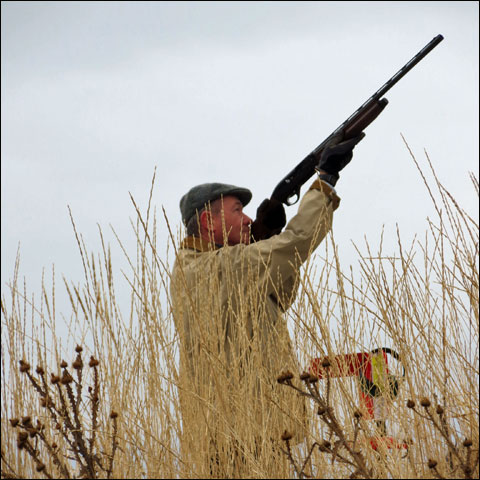 Sam Rankin at a peg.
Sam Rankin at a peg.
Overnight brought spring rain that transformed the snow to mud (speaking of England). A nourishing breakfast taken in the lodge dining room presented views of thinning Pacific mist with fissures of sunlight that imposed almighty shadows on the hills. Temperatures into the forties augured vest outer wear for the hearty and ideal conditions for the dogs.
A row of stream-side pegs faced the steep, curved cliff with another rise behind us. Our positions in the ravine had been determined by the morning draw. As Shoot Captain, Mr. Batha sidled up to us guns, giving pointers. Guides and their dogs waited at the ready. The guns stayed quiet, contemplative, watching the tall ridge in anticipation. Rushing water and wind articulated the land’s native beauty fragrant with sage.
The whistle blows. Shotguns are loaded and locked. A blast shatters the silence and in the distance a pheasant drops. “Nice shot,” someone calls.
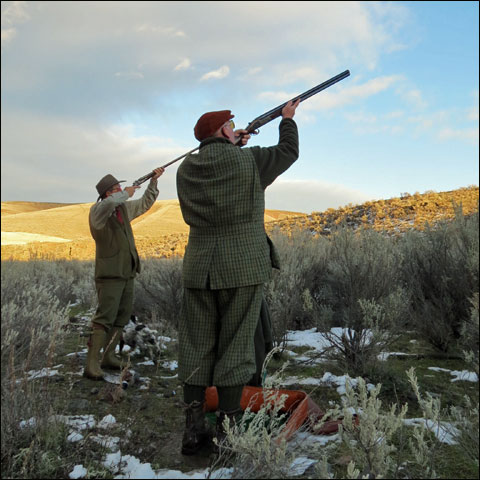 Nary a pheasant escaped the shooting of Michael Coleman (left) and Chris Batha during the drives.
Nary a pheasant escaped the shooting of Michael Coleman (left) and Chris Batha during the drives.
Pheasants reveal themselves like a fireworks display. Gradually to start, then build into a crescendo. The ravine echoes with gunfire. The birds, driven from the cliff, fly briefly then cut their wings and soar on the wind at afterburner velocities heading for cover on the hillsides yonder.
My station, at the end of the line, presented pheasants generally veering away in very long shots. The Perazzi MX20 choked tight, I hit seven that first morning, or about 40 percent of total shots taken.
Gunfire unremitting, dogs scrambled into the quick stream fetching birds, crisscrossed the landscape and conquered the hills behind us. Feathered piles rapidly grew around the guides. Pheasants continuously tumbled from the sky. At the second whistle, it all turned quiet again.
 Bill Toriello in action at a beautiful peg.
Bill Toriello in action at a beautiful peg.
We assembled for an English mid-morning break called elevenses: hot cocoa, beef bouillon, scones, coffee and tea around a blazing fire. The guides, meanwhile, worked hard at collecting birds before we relocated to the next drive.
Clambering into the rugged vehicles for a bouncy ride across Highland Hills Ranch, adrenaline fueled our conversation about an astonishing wild — theatrical and exuberant — and we stood ready for more.
After our second pheasant drive of the morning, lunch was taken in the lodge. Hearty soups and chili capped by mind-blowing desserts would be followed by catnaps on plush sofas or delving into emails with valley vistas as a backdrop until The Captain called for the third drive.
By the next day, temperatures would rise, blessing us with high-altitude crystalline skies and moderate winds for three enjoyable pheasant drives.
 Vivian Pearce looks back into the hills after a day of driven pheasants.
Vivian Pearce looks back into the hills after a day of driven pheasants.
Highland Hills Ranch estimates a team of guns will average one in three shots during a driven pheasant hunt. Bottom line: after two solid days on the pegs, the guns still leave some 400 pheasants scattered throughout the cover, offering shooting over dogs for the “Grand Slam of Wingshooting” that also includes chukar, valley quail and huns.
So with day four comes a dramatic change of pace. After the first day of simulated pheasant shooting, followed by two days that boasted six thrilling pheasant drives, our final hunt at Highland Hills Ranch flushes out the “Grand Slam of Wingshooting.”
By now, the Pacific atmosphere carried a false spring of sweet air and radiant warmth with refreshing breezes. Mr. Batha and I took to fields of corn, milo and tall grass led by guide Gene Barnhart of Vallivue Sporting Dogs. Mr. Barnhart, experienced and affable, proved a wonderful companion as his dogs explored for birds.
The Perazzi MX20 shouldered fast, leveraged by a slender forend and receiver that instilled control during flushes. Its exceptional sight picture and barrel regulation contributed to successful long crossing and quartering shots that brought huzzahs. Mr. Batha called the MX20 “lively” — an apt description I would later appreciate during that afternoon hunt on the hilltop.
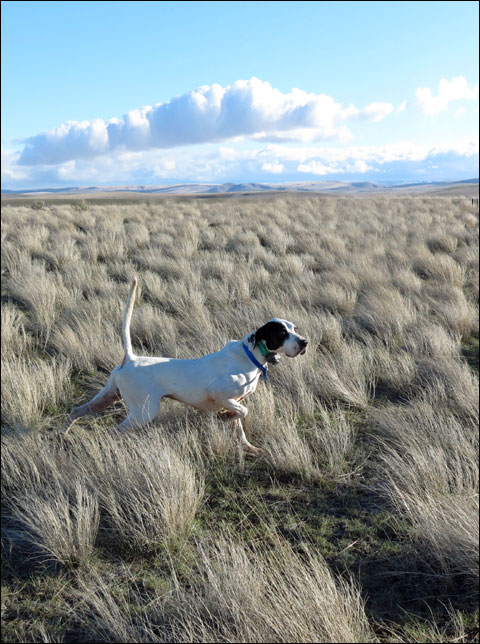 One of Gene Barnhart’s English Pointers during the chukar hunt.
One of Gene Barnhart’s English Pointers during the chukar hunt.
Mr. Barnhart’s massive Ford diesel pick-up labored higher and higher until we reached an old ranch fence. Two dogs sprung from their kennels situated in the bed and immediately started working the bunchgrass. Up here, the wind felt defiant — a guardian spirit who defended dreamland.
We followed both dogs, zigzagging and alive with anticipation of the next opportunity. Chukars flushed into panorama vistas of winter-silver grassland beneath the cobalt brilliance. Far-away shots, upwards of 40 yards, burst from the earth for a holy reckoning over 29½-inch barrels. After two hours, 19 chukars and a pair of huns were downed.
Walking back to the truck together, the MX20 broken open over my shoulder, I turned to Mr. Barnhart and confessed, “I could die now a happy man.”
Irwin Greenstein is the Publisher of Shotgun Life. You can reach him at contact@shotgunlife.com.
Useful resources:
The Highland Hills Ranch web site
The Perazzi web site
Chris Batha’s web site
The Beretta Trident Program web site
The Vallivue Sporting Dogs web site

Irwin Greenstein is Publisher of Shotgun Life. Please send your comments to letters@shotgunlife.com.


Comments